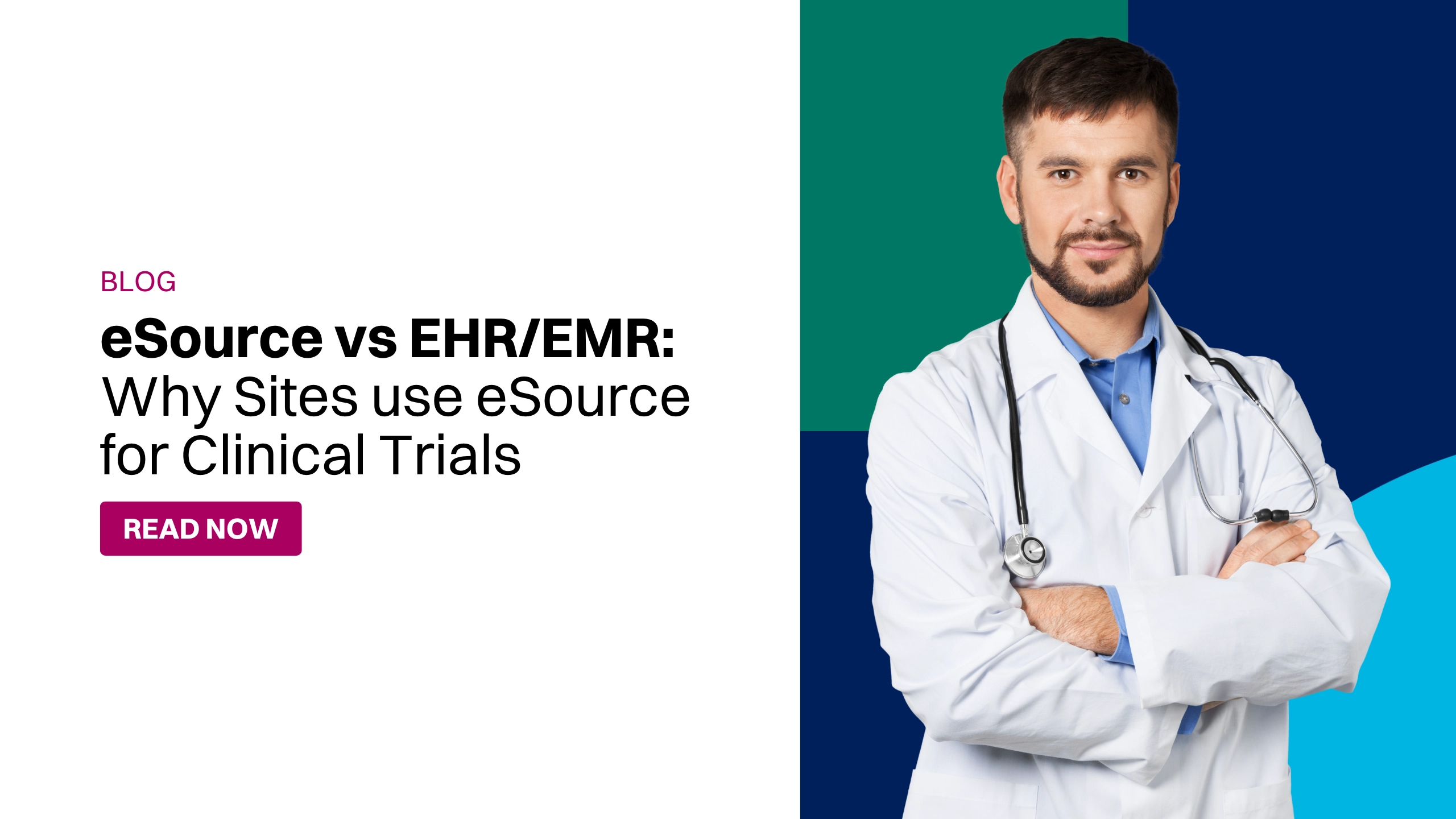The integration of technology in clinical trials increases accuracy, efficiency, and regulatory compliance. While both Electronic Health Records (EHRs) and electronic Source Data (eSource) systems are key components in this shift, they serve fundamentally different functions within the clinical trial process. What’s the difference? EHRs primarily focus on patient care and are intended for clinical workflows, whereas eSource is purpose-built for managing clinical trial data.
In fact, clinical research sites prefer and adopt eSource systems for clinical trials because they reduce data transcription errors, improve real-time data capture, and strengthen audit processes. eSource allows for more direct and compliant data collection, improving both data integrity and site efficiency.
Understanding these distinctions is essential for optimizing clinical trial processes and addressing common concerns during the eSource system sales process. Whether it’s ensuring compliance with FDA 21 CFR Part 11 or enabling remote monitoring in decentralized or hybrid trials, eSource provides specialized features that traditional EHR systems lack, making it the preferred choice for conducting clinical trials. In this blog, we’ll unpack the key difference between eSource vs EHR/EMR and explain why sites use eSource for clinical trials.
What is EHR/EMR?
Electronic Health Records (EHR), sometimes referred to as Electronic Medical Records (EMR), are electronic versions of the traditional paper charts in clinician offices. They contain standard medical and clinical data gathered in provider’s offices and are primarily designed for direct patient care. EHRs allow clinicians to track data over time, identify patients for preventive visits and screenings, monitor patients, and improve health care quality directly within the clinical setting.
What is eSource?
eSource, by contrast, refers specifically to the collection of clinical trial data in electronic form at its source, which includes a broader range of data types not limited to medical health records. eSource solutions are intended for use in clinical trials and are designed to capture, store, and manage all data points directly related to trial outcomes in real-time. This can include data from lab results, patient diaries, ECGs, and other data directly entered by site staff.
Key Differences - eSource vs EHR/EMR
The key distinctions between EHRs and eSource stem from their intended purpose and design. EHRs are geared toward continuous patient care and managing comprehensive patient medical histories. They enhance accessibility and sharing across healthcare providers. In contrast, eSource is tailored for clinical trials and is 21 CFR Part 11 compliant. It emphasizes data compliance with stringent regulatory requirements, detailed protocol adherence. Furthermore, it ensures the accuracy and validity of clinical data for regulatory review.
Significantly, eSource systems provide functionalities critical for clinical trials not typically supported by EHRs. These include complex data capture mechanisms, real-time data analysis, and specialized reporting that aligns with clinical trial management. Additionally, eSource systems are designed to facilitate easier and more efficient audits and inspections by regulatory bodies.
Why eSource is More Beneficial for Sites
One analysis published by the National Library of Medicine emphasizes that while EHRs are designed primarily for patient care, eSource is specifically built for clinical trials. It offers features that improve data quality, enable real-time data capture, and reduce manual errors, making it an essential tool for modern clinical trials. In fact, the analysis further suggests that integrating EHRs with sponsor platforms, such as an EDC or data warehouse/eSource system, can greatly improve efficiencies for both site and sponsor workflows by removing the need for duplicate data entry and minimizing data reconciliation between the source and sponsor databases.
There are many benefits of using eSource, such as improved data accuracy and reduced transcription errors. Also, eSource significantly shortens the time needed for data verification compared to traditional paper methods. Moreover, eSource ensures higher data integrity by minimizing human errors through direct data entry. It supports strict regulatory compliance with built-in features that maintain detailed audit trails and data traceability, essential during audits. This operational streamlining is complemented by the system’s capacity for remote monitoring, which has become increasingly vital in contemporary clinical trial contexts.
Today, sponsors now expect and support the use of eSource systems, recognizing that it improves adherence to the protocol, reduces FDA audit risk, and ensures real-time access to accurate and reliable data.
Wrap Up
While EHRs are invaluable tools for patient care, eSource provides a specialized, 21 CFR Part 11 compliant system designed for the unique demands of clinical trials. Understanding these differences helps clarify why eSource is an essential eClinical platform, particularly for sites looking to increase their capabilities to manage more studies and scale faster.
For clinical trial sites aiming to improve performance, reduce administrative burdens, and ensure compliance with strict regulations, adopting eSource is a strategic move. As clinical research continues to embrace electronic solutions, eSource is increasingly becoming the gold standard for data collection and management, helping sites meet the complex demands of modern clinical trials and ultimately delivering better outcomes.

